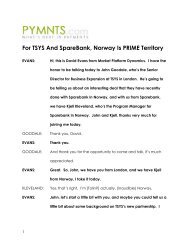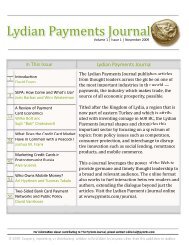Two-Sided Market - PYMNTS.com
Two-Sided Market - PYMNTS.com
Two-Sided Market - PYMNTS.com
Create successful ePaper yourself
Turn your PDF publications into a flip-book with our unique Google optimized e-Paper software.
1 TABLE OF CONTENTS<br />
Preface<br />
Given the subject of this collection, there is some irony in how I’ve chosen<br />
to bring these essays to you. Publishing has traditionally been a two-sided model.<br />
Publishers get authors and readers together. They typically make their money<br />
by charging the reader and giving some fraction of the earnings to the author as<br />
royalties.<br />
This 20th century model of publishing doesn’t serve authors of academic<br />
books well. Often, publishers set the price of academic books relatively high,<br />
expecting to earn the greatest profits from libraries and a handful of aficionados.<br />
For most books that aren’t aimed towards a popular audience, including most<br />
academic books, royalties are quite small. Optimistically, I might have been able<br />
to buy a pretty good new bicycle if I had published these essays in the traditional<br />
fashion, but I’d rather have more people read my work than collect the chump<br />
change from royalties.<br />
Therefore, the two-sided publishing model fails in two ways: the author<br />
doesn’t make much money, and the author doesn’t get read by very many<br />
people. Moreover, most publishers in my experience are still using 20 th century<br />
technology to produce and distribute books. It can take many months—if not<br />
years—from a book’s conception to its appearance in a reader’s hands.<br />
The irony is apparent that, in order to bring my work into the 21 st century,<br />
I have decided to publish my collection of essays about two-sided markets in a<br />
one-sided way. I ditched the intermediary and chose to connect directly with<br />
likely readers. I’m sure some of you would prefer the feel of paper and leather but<br />
hopefully the price is right. It was easy for me to decide to make this volume free<br />
because it cost almost nothing to produce and distribute it.<br />
This version of the book consists of a series of urls (website addresses) that<br />
will take you to the original papers. It is easy to download and store them as pdfs<br />
on your iPad or whatever e-reader you use, as well as on your personal <strong>com</strong>puter.<br />
For those who find multiple downloading inconvenient, just wait: I am planning<br />
to release a downloadable pdf of the entire volume in the early part of 2011. It<br />
will have all of the chapters available in a single download.<br />
This approach is novel, and no doubt imperfect, but I’d like to make it better<br />
next time. Please feel free to post your <strong>com</strong>ments on the LinkedIn group that I’ve<br />
created (<strong>Two</strong>-<strong>Sided</strong> <strong>Market</strong> Economics, Strategy, and Law) or email me directly<br />
at david.evans@marketplatforms.<strong>com</strong> with your suggestions.<br />
- David S. Evans
2 TABLE OF CONTENTS<br />
Acknowledgements<br />
I would like to thank Richard Schmalensee for his collaboration on several of the<br />
articles and books on multi-sided platforms we have done over the last decade as well as<br />
Jean-Charles Rochet and Jean Tirole who have been generous with their <strong>com</strong>ments and<br />
time. None of them necessarily agrees with anything I say of course. I also want to extend<br />
my appreciation to Justin Unger who led the effort to design and assemble this book.
3 TABLE OF CONTENTS<br />
Introduction<br />
This volume collects a series of essays that I have written, sometimes with colleagues,<br />
over the last decade on businesses that create value by providing products<br />
that enable two or more different types of customers to get together, find each<br />
other, and exchange value. These businesses were called “two-sided markets” in the seminal<br />
paper by Jean-Charles Rochet and Jean Tirole that was first circulated in 2001. 1 I typically<br />
avoid this term since it tends to obscure the fact that we are talking about businesses rather<br />
than markets. I prefer the term “multi-sided platforms” because these businesses provide a<br />
place for customers to meet and interact and often support more than two interdependent<br />
types of customers. In writing for business audiences I use the term “catalyst” to denote the<br />
fact that these businesses create value that couldn’t be had without bringing these customer<br />
types together. 2 The term “two-sided markets” has stuck, though, and I will use it here.<br />
The Rochet and Tirole paper ignited work on two-sided markets in economics, law, and<br />
business. Several other papers, in circulation around 2000, touched on some of the interesting<br />
aspects of intermediaries 3 or on the increasingly widespread phenomenon of giving one<br />
product away for free to attract revenue from another product. 4 The Toulousians’ contribution<br />
was fundamental because it recognized for the first time that a very diverse set of businesses<br />
were two-sided, presented an elegant economic model of them, and derived several<br />
robust aspects of these businesses including the critical importance of the price structure (the<br />
relative prices charged to the various types of customers) in their making money.<br />
Economic theorists and empiricists were quickly attracted to this topic. The mill of articles<br />
and dissertations has flourished ever since. 5 It soon became apparent that this new<br />
area had important implications for antitrust. Many <strong>com</strong>petition authorities took notice<br />
and law review articles addressed various aspects of these newly-recognized business forms. 6<br />
The corporate world seized on this new field. Strategy articles and courses focused on these<br />
platforms began appearing. 7 Companies found the subject eye opening, including firms that<br />
were multi-sided platforms but had not quite understood the ramifications. 8
My modest contributions to this literature are presented in this volume. Part I presents<br />
background pieces on the economics of multi-sided platforms and industries in which these<br />
platforms are <strong>com</strong>mon. Part II examines the antitrust economics of two-sided markets including<br />
the difficult problem of defining the boundaries of <strong>com</strong>petition. Part III <strong>com</strong>prises several<br />
papers that apply two-sided market analysis to web-based businesses. Part IV does the same<br />
for payment cards which is the industry that attracted much of the early two-sided analysis—<br />
in part because this framework was helpful for understanding the hotly debated issue of interchange<br />
fees. Part V collects several article and book chapters on software platforms. These<br />
platforms have be<strong>com</strong>e especially important in the last several years because they are now the<br />
basis for revolutionary developments with mobile devices (e.g. the iPhone and Android), social<br />
networking (Facebook in particular), and payments (PayPalX). The essays are published as<br />
originally written (usually, in fact, whatever version I could make freely available).<br />
When the theory of two-sided markets was first introduced it was <strong>com</strong>mon to hear at<br />
least two <strong>com</strong>plaints. The first was that there was nothing new—from economists who suggested<br />
that it was just the indirect network effects wine in new bottles or antitrust analysts who<br />
<strong>com</strong>mented that it had all been considered before in advertising cases. The second was that<br />
it was a theory of everything, and therefore nothing, since everything seems to be two-sided.<br />
There’s some truth of course to both <strong>com</strong>ments. Indirect network effects are usually essential<br />
to understanding two-sided markets. But the network effects literature among other<br />
things missed the importance of these effects for a very diverse group of industries; the literature<br />
spent a lot of time on fax machines and video standards but not so much on more general<br />
business issues such as pricing or industries such as shopping malls that did not obviously<br />
have indirect network effects. One of the problems with two-sided market analysis is that it is<br />
hard to find formal limiting principles, but that isn’t un<strong>com</strong>mon in economics. Sometimes a<br />
two-sided market perspective is highly informative while other times it isn’t. It matters when<br />
it matters. What’s now very clear, with the benefit of a decade of work, is that the study of<br />
multi-sided platforms has provided valuable insights to economists, policymakers and business<br />
people. I hope the chapters below account for a sliver of those.<br />
4 TABLE OF CONTENTS<br />
Introduction
1 Jean-Charles Rochet and Jean Tirole, “Platform Competition in <strong>Two</strong>-<strong>Sided</strong> <strong>Market</strong>s,”<br />
Journal of the European Economic Association 1, no. 4 (2003): 990-1209.<br />
2 David S. Evans and Richard Schmalensee, Catalyst Code: The Strategies behind the<br />
World’s Most Dynamic Companies (Cambridge, MA: Harvard Business School Press,<br />
2007).<br />
3 Bernard Caillaud and Bruno Jullien, " Chicken & Egg: Competition among Intermediation<br />
Service Providers," RAND Journal of Economics, The RAND Corporation, vol.<br />
34(2), pages 309-28, Summer.<br />
4 Geoffrey Parker and Marshall Van Alstyne (2005). “<strong>Two</strong>-<strong>Sided</strong> Network Effects: A<br />
Theory of Information Product Design.” Management Science, Vol. 51, No. 10.<br />
5 With the recent important work of Glen Weyl we have moved on to <strong>Two</strong>-<strong>Sided</strong> <strong>Market</strong>s<br />
2.0. See Glen Weyl, “A Price Theory of Multi-<strong>Sided</strong> Platforms,” American Economic<br />
Review, 2010, 100(4).<br />
6 OECD Organization for Economic Co-operation and Development (“OECD”), <strong>Two</strong>-<br />
<strong>Sided</strong> <strong>Market</strong>s, DAF/COMP (2009) 20, 28.<br />
7See, for example, Thomas Eisenmann “Managing Networked Businesses: Course Overview.”<br />
Harvard Business Online , 2006;Thomas Eisenmann, Geoffrey Parker, and Marshall<br />
Van Alstyne, “Strategies for <strong>Two</strong>-<strong>Sided</strong> <strong>Market</strong>s.” Harvard Business Review, 2006.<br />
8Companies in the payment card industry, for example, have fundamentally changed<br />
how they think about that business as a result of the two-sided market concepts.<br />
5 TABLE OF CONTENTS<br />
Introduction
6<br />
Introduction<br />
Part One: Economics of Multi-<strong>Sided</strong> Platform Businesses<br />
Chapter 1: Industrial Organization of <strong>Two</strong>-<strong>Sided</strong> Platforms<br />
Chapter 2: Some Empirical Aspects of Multi-<strong>Sided</strong> Platform Industries<br />
Chapter 3: How Catalysts Ignite: The Economics of Platform-Based Startups<br />
Part <strong>Two</strong>: <strong>Two</strong>-<strong>Sided</strong> Antitrust Economics<br />
Chapter 4: Antitrust Economics of Multi-<strong>Sided</strong> Platforms<br />
Chapter 5: <strong>Two</strong>-<strong>Sided</strong> <strong>Market</strong> Definition<br />
Chapter 6: Defining <strong>Market</strong>s that Involve <strong>Two</strong>-<strong>Sided</strong> Platform<br />
Part Three: Web Based Platforms<br />
Chapter 7: Economics of the Online Advertising Industry<br />
Chapter 8: The Online Advertising Industry: Economics, Evolution, and Privacy<br />
Chapter 9: Web Economy, <strong>Two</strong>-<strong>Sided</strong> <strong>Market</strong>s, and Competition Policy<br />
Chapter 10: Antitrust Issues Raised by Global Internet Economy<br />
Part Four: Payment Cards<br />
Chapter 11: More Than Money<br />
Chapter 12: Interchange Fees and Their Regulation<br />
Chapter 13: The Effect of Regulatory Intervention in <strong>Two</strong>-<strong>Sided</strong> <strong>Market</strong>s<br />
Part Five: Software Platforms<br />
About The Author<br />
Chapter 14: Invisible Engines: Introduction to the Chinese Edition<br />
Chapter 15: Invisible Engines: Both Sides Now<br />
Chapter 16: What’s Next in Payments: Invisible Engines
CHAPTER ONE<br />
Industrial organization of <strong>Two</strong>-<strong>Sided</strong> Platforms<br />
CHAPTER TWO<br />
Some Empirical Aspects of Multi-<strong>Sided</strong> Platform Industries<br />
CHAPTER THREE<br />
How Catalysts Ignite:<br />
The Economics of Platform-Based Startups<br />
7 TABLE OF CONTENTS<br />
Part One<br />
Abstract:<br />
Many diverse industries are populated by businesses that operate two-sided platforms. These<br />
businesses serve distinct groups of customers who need each other in some way, and the core<br />
business of the two-sided platform is to provide a <strong>com</strong>mon (real or virtual) meeting place and to<br />
facilitate interactions between members of the two distinct customer groups. Platforms play an<br />
important role throughout the economy by minimizing transactions costs between entities that can<br />
benefit from getting together. In these businesses, pricing and other strategies are strongly affected<br />
by the indirect network effects between the two sides of the platform. As a matter of theory, for<br />
example, profit-maximizing prices may entail below-cost pricing to one set of customers over the<br />
long run and, as a matter of fact, many two-sided platforms charge one side prices that are below<br />
marginal cost and are in some cases negative. These and other aspects of two-sided platforms<br />
affect almost all aspects of antitrust analysis - from market definition, to the analysis of cartels,<br />
single-firm conduct, and efficiencies. This paper provides a brief introduction to the economics of<br />
two-sided platforms and the implications for antitrust analysis.<br />
Abstract:<br />
Multi-sided platform markets have two or more different groups of customers that businesses<br />
have to get and keep on board to succeed. These industries range from dating clubs (men and<br />
women), to video game consoles (game developers and users), to payment cards (cardholders and<br />
merchants), to operating system software (application developers and users). They include some of<br />
the most important industries in the economy. A survey of businesses in these industries shows that<br />
multi-sided platform businesses devise entry strategies to get multiple sides of the market on board<br />
and devise pricing, product, and other <strong>com</strong>petitive strategies to keep multiple customer groups on a<br />
<strong>com</strong>mon platform that internalizes externalities across members of these groups.<br />
Abstract:<br />
Entrepreneurs who start multi-sided platforms must secure enough customers on both sides,<br />
and in the right proportions, to provide enough value to either group of customers and to achieve<br />
sustainable growth. In particular, these entrepreneurs must secure “critical mass” to ignite the<br />
growth of their platforms; the failure to achieve “critical mass” quickly results in the implosion of<br />
the platform. There are a number of strategies available to entrepreneurs to reach critical mass.<br />
For example, the “zig-zag” strategy involves successive accretions of customers on both sides to<br />
build up the value to both. The relevant strategies depend in large part on whether the nature of<br />
the platform requires securing participation by both platform sides at launch (e.g. dating venues),<br />
whether it is possible to acquire one side before approaching the other side (e.g. search engines),<br />
and whether it is necessary to make pre-<strong>com</strong>mitments to one side to induce them to make<br />
investments (e.g. video games).<br />
EConoMICS of MulTI-SIdEd<br />
PlATforM BuSInESSES
CHAPTER FOUR<br />
CHAPTER FIVE<br />
<strong>Two</strong>-<strong>Sided</strong> <strong>Market</strong> definition<br />
CHAPTER SIX<br />
8 TABLE OF CONTENTS<br />
Part <strong>Two</strong><br />
Antitrust Economics of Multi-<strong>Sided</strong> Platforms<br />
Abstract:<br />
“<strong>Two</strong>-sided” markets have two different groups of customers that businesses have to get on board<br />
to succeed - there is a “chicken-and-egg” problem that needs to be solved. These industries<br />
range from dating clubs (men and women), to video game consoles (game developers and<br />
users), to credit cards (cardholders and merchants), and to operating system software (application<br />
developers and users). They include some of the most important industries in the economy.<br />
<strong>Two</strong>-sided firms behave in ways that seem surprising from the vantage point of traditional<br />
industries, but in ways that seem like plain <strong>com</strong>mon sense once one understands the business<br />
problems they must solve. Prices do not and prices cannot follow marginal costs in each side of the<br />
market. Price levels, price structures, and investment strategies must optimize output by harvesting<br />
the indirect network effects available on both sides. By doing so, businesses in two-sided industries<br />
get both sides on board and solve the chicken-and-egg problem. There is no basis for asking<br />
regulators or antitrust enforcers to steer clear of these industries or to spend extra effort on them.<br />
The antitrust analysis of these industries, however should heed the economic principles that govern<br />
pricing and investment decisions in these industries.<br />
Abstract:<br />
This paper addresses the analysis of market definition when the parties involved in an antitrust<br />
or merger analysis include one or more two-sided platforms. We discuss how standard market<br />
definition measures such as SSNIP tests, diversion ratios, and conditional logit demand analyses<br />
have to be modified to account for the unique characteristics of two-sided platforms. We also<br />
review how market definition of two- sided platforms was treated in recent US and EC case law.<br />
defining <strong>Market</strong>s that Involve <strong>Two</strong>-<strong>Sided</strong> Platforms<br />
Abstract:<br />
A multi-sided platform (MSP) serves as an intermediary for two or more groups of customers<br />
who are linked by indirect network effects. Recent research has found that MSPs are significant<br />
in many industries and that some standard economic results - such as the Lerner Index - do not<br />
apply to them, in material ways, without some significant modification to take linkages between the<br />
multiple sides into account. This article extends several key tools used for the analysis of mergers<br />
to situations in which one or more of the suppliers are MSPs. It shows that the application of<br />
traditional tools to mergers involving MSPs results in biases the direction of which depends on the<br />
particular tool being used and other conditions. It also extends these tools to the analysis of the<br />
merger of MSPs. The techniques are illustrated with an application to an acquisition by Google in<br />
the online advertising industry.<br />
TWo-SIdEd AnTITruST<br />
EConoMICS
CHAPTER EIGHT<br />
The online Advertising Industry: Economics, Evolution, and Privacy<br />
CHAPTER NINE<br />
9 TABLE OF CONTENTS<br />
Part Three<br />
CHAPTER SEVEN<br />
Economics of the online Advertising Industry<br />
Abstract:<br />
Online advertising has grown rapidly and accounts for about 7% of US advertising spending. It is projected to increase<br />
sharply as more consumers spend time online on their personal <strong>com</strong>puters and as additional devices such as mobile<br />
phones and televisions are connected to the web. This article describes how the online advertising industry works. The<br />
industry is populated by a number of multisided platforms that singly or in <strong>com</strong>bination facilitate connecting advertisers<br />
to viewers. Search-based advertising platforms, the most well developed of these, has several interesting economic<br />
features that result from the <strong>com</strong>bination of keyword bidding by advertisers and single-homing.<br />
Abstract:<br />
Online advertising accounts for almost 9 percent of all advertising in the United States. This share is expected to<br />
increase as more media is consumed over the internet and as more advertisers shift spending to online technologies.<br />
The expansion of internet-based advertising is transforming the advertising business by providing more efficient<br />
methods of matching advertisers and consumers and is transforming the media business by providing a source of<br />
revenue for online media firms that <strong>com</strong>pete with traditional media firms. The precipitous decline of the newspaper<br />
industry is one manifestation of the symbiotic relationship between online content and online advertising. Onlineadvertising<br />
is provided by a series of interlocking multi-sided platforms (also known as two-sided markets) that facilitate<br />
the matching of advertisers and consumers. These intermediaries increasingly make use of detailed individual data,<br />
predictive methods, and matching algorithms to create more efficient matches between consumers and advertisers.<br />
Some of their methods raise public policy issues that require balancing providing consumers more valuable advertising<br />
against the possible loss of valuable privacy.<br />
Web Economy, <strong>Two</strong>-<strong>Sided</strong> <strong>Market</strong>s, and Competition Policy<br />
Abstract:<br />
The web economy has grown rapidly in the last decade. Online businesses have several key features that are<br />
important for understanding the pro-<strong>com</strong>petitive and anti-<strong>com</strong>petitive strategies they may engage in. The two-sided<br />
markets literature helps elucidate many of these strategies. It also provides guidance for the antitrust analysis of market<br />
definition and exclusionary practices for web-based businesses.<br />
CHAPTER TEN<br />
Antitrust Issues raised by the Emerging Global Internet Economy<br />
Abstract:<br />
Web-based businesses are increasingly the subject of antitrust concerns. Plaintiffs in the United States have sued<br />
eBay for tying its online payments service to its transaction service. Multiple jurisdictions in the European Community<br />
have claimed that Apple has violated the <strong>com</strong>petition laws by limiting the ability of its music player to play music<br />
from <strong>com</strong>peting music stores and limiting the ability of <strong>com</strong>peting music players to play music purchased from its<br />
music stores. During 2007, although the U.S. Federal Trade Commission decided not to block Google’s acquisition<br />
of DoubleClick after a lengthy investigation, it expressed its intent to “closely watch these markets” involved in online<br />
advertising. The web economy poses two major challenges to <strong>com</strong>petition authorities. The law and economics for<br />
analyzing the multi-sided platforms that dominate the internet sector is not well developed. At the same time the<br />
web-economy is evolving very rapidly and in ways that are sure to result in antitrust <strong>com</strong>plaints and investigations.<br />
Competition authorities and courts will need to exercise great care in balancing the protection of consumers from<br />
anti<strong>com</strong>petitive behavior against causing harm from interfering in <strong>com</strong>plex businesses that are both rapidly moving and<br />
not fully understood.<br />
WEB BASEd PlATforMS
CHAPTER ELEVEN<br />
More Than Money<br />
CHAPTER TWELVE<br />
Interchange fees and Their regulation<br />
10 TABLE OF CONTENTS<br />
Part Four<br />
Abstract:<br />
The simple payment card has been around since at least the beginning of the twentieth century.<br />
Hotels, oil <strong>com</strong>panies, and department stores issued cards before World War I. In response to<br />
customer requests, Sears began offering lines of credit in 1910 to customers of “unquestionable<br />
responsibility,” although the Sears card came more than a decade later. Some large retailers<br />
gave cards to their wealthier customers that identified them as having a charge account with the<br />
store. By the 1920s, several department stores allowed cardholders to pay off their bills in monthly<br />
installments. Metal “charge-plates” with embossed consumer information were introduced by<br />
department stores in 1928. During the 1920s as well, oil <strong>com</strong>panies issued “courtesy cards” for<br />
charging gas. By the end of World War II, charge cards were no longer a novelty, but they were<br />
about as far from the cards of today as barter was from coin.<br />
Abstract:<br />
This essay surveys the economic literature on interchange fees and the debate over whether interchange<br />
should be regulated and, if so, how. We consider, first, the operation of unitary payment systems, like<br />
American Express, in the context of the recent economic literature on two-sided markets, in which<br />
businesses cater to two interdependent groups of customers. The main focus is on the determination<br />
of price structure. We then discuss the basic economics of multi-party payment systems and the role<br />
of interchange in the operation of such systems under some standard, though unrealistic, simplifying<br />
assumptions. The key point of this discussion is that the interchange fee is not an ordinary price; its most<br />
direct effect is on price structure, not price level.<br />
PAYMEnT CArdS<br />
We then examine the implications for privately determined interchange fees of some of the relevant market<br />
imperfections that have been discussed in the economic literature. While some studies suggest that<br />
privately determined interchange fees are inefficiently high, others point to fees being inefficiently low. Moreover, there is a consensus<br />
among economists that, as a matter of theory, it is not possible to arrive, except by happenstance, at the socially optimal interchange<br />
fee through any regulatory system that considers only costs. This distinguishes the market imperfections at issue here for multi-party<br />
systems from the more familiar area of public utility regulation, where setting price equal to marginal cost is theoretically ideal.<br />
Next, we consider the issues facing policy makers. Since there is so much uncertainty about the relation between privately and socially<br />
optimal interchange fees, the out<strong>com</strong>e of a policy debate can depend critically on who bears the burden of proof under whatever set<br />
of institutions and laws the deliberation takes place. There is no apparent basis in today’s economics - at a theoretical or empirical<br />
level - for concluding that it is generally possible to improve social welfare by a noticeable reduction in privately set interchange fees.<br />
Thus, if antitrust or other regulators had to show that such intervention would improve welfare, they could not do so. This, again, is quite<br />
unlike public utility regulation or many areas of antitrust including, in particular, ordinary cartels. By the same token, there is no basis in<br />
economics for concluding that the privately set interchange fee is just right. Thus, if card associations had to bear the burden of proof -<br />
for example, to obtain a <strong>com</strong>fort or clearance letter from authorities for engaging in presumptively illegal coordinated behavior - it would<br />
be difficult for them to demonstrate that they set socially optimal fees.<br />
We take a pragmatic approach by suggesting two fact-based inquiries that we believe policymakers should undertake before<br />
intervening to affect interchange. First, policymakers should establish that there is a significant market failure that needs to be<br />
addressed. Second, policymakers should establish that it is possible to correct a serious market imperfection, assuming one exists,<br />
by whatever intervention they are considering (such as cost-based regulation of interchange fee levels) and thereby to increase social<br />
welfare significantly after taking into account other distortions that the intervention may create. We illustrate both of these points by<br />
examining the recent Australian experience.
CHAPTER THIRTEEN<br />
11 TABLE OF CONTENTS<br />
Part Four<br />
The Effect of regulatory Intervention in <strong>Two</strong>-<strong>Sided</strong> <strong>Market</strong>s:<br />
An Assessment of Interchange-fee Capping in Australia<br />
Abstract:<br />
The Reserve Bank of Australia reduced interchange fees by almost half thereby eliminating a significant<br />
source of revenue to issuers of credit cards. The purpose of this intervention was to align the prices of<br />
using various payment instruments with their social costs and thus reduce the use of cards, which the RBA<br />
viewed as a socially less efficient payment method than cash, checks, and PIN debit cards. The shortrun<br />
result of this regulatory intervention has been the following: (1) Bank issuers have increased the fixed<br />
prices for cards and thereby recovered between 30 and 40 percent of the loss of interchange fee revenue;<br />
this fraction is likely to increase over time as cards renew and new solicitations go out. Bank issuers have<br />
not changed the per-transaction fees for cards much. (2) Merchants experienced a very small reduction<br />
in their costs. Both theory and limited empirical evidence suggest that the highly concentrated merchant<br />
sector in Australia has captured the reduction in interchange fees as profits and has not passed it on in<br />
the form of lower consumer prices. (3) The per-transaction price at the point of sale has not changed<br />
significantly. Merchants have not generally availed themselves of their right to surcharge card transactions<br />
and the per-transaction price faced by consumers from their card issuers has not changed much. Holding<br />
the number of cards fixed, the regulatory intervention has not altered prices in a way that could achieve<br />
the intent of the intervention. (4) There is relatively little evidence thus far that the intervention has in fact<br />
affected the volume of card transactions in Australia as intended by the regulation. (5) In the short-run, the<br />
effect of the regulation has been to transfer significant profits to the Australian merchant sector with that<br />
transfer being borne partly by bank issuers and partly by cardholders. (6) Since proprietary systems such<br />
as American Express were not subject to the pricing regulations and since American Express can enter into<br />
deals with banks to issue cards, banks have shifted volume from the regulated association systems to the<br />
unregulated proprietary systems.<br />
PAYMEnT CArdS
CHAPTER FIFTEEN<br />
Invisible Engines: Both Sides now<br />
CHAPTER SIXTEEN<br />
12 TABLE OF CONTENTS<br />
Part Five<br />
CHAPTER FOURTEEN<br />
Invisible Engines: Introduction to the Chinese Edition<br />
Abstract:<br />
The use of software platforms to drive innovation and transform industries has exploded in the<br />
four years since the publication of the English-language edition of Invisible Engines in 2006.<br />
Around the globe, invisible engines are ushering in a new era of software-based technological<br />
change. The Apple iPhone has shaken the mobile phone industry worldwide in part by creating a<br />
massive applications business built on the phone’s operating system. Firefox has revolutionized<br />
the browser industry by encouraging web developers to write add-ons and in doing so toppled<br />
Microsoft’s Internet Explorer from dominance in many countries. Facebook has created a powerful<br />
social networking platform by opening itself up to developers. Amazon has released a cloud<strong>com</strong>puting<br />
platform that enables entrepreneurs to access its vast software, hardware and global<br />
<strong>com</strong>munication systems over the Internet. A less well known <strong>com</strong>pany, IPCommerce, is starting to<br />
transform the payments business in the United States by helping developers build applications that<br />
work with the diverse hardware and software than handle the various types of payments.<br />
In this preface to the 2010 Chinese edition of Invisible Engines we will survey what has happened<br />
since we finished the book and explain why software platform-based business models continue<br />
to create enormous social value, while often producing great profits for the <strong>com</strong>panies and<br />
entrepreneurs behind them.<br />
Abstract:<br />
<strong>Two</strong> features of the technology we described in the last chapter shape the economics of software<br />
platforms. Software platforms are a written product of the mind. They are in effect documents,<br />
usually written in a high-level <strong>com</strong>puter language. The code involved is malleable. It can be moved,<br />
altered, added to, and sub-tracted from with great ease. It is created almost entirely by people—<br />
“almost” because, like <strong>com</strong>posers and writers, most programmers use <strong>com</strong>puters for help. Software<br />
platforms are inherently multisided. They usually serve distinct groups of customers, who benefit<br />
from having each other on the same platform. Application Programming Interfaces (APIs) forge the<br />
crucial relationship between application developers and end users.<br />
What’s next in Payments: Invisible Engines<br />
Abstract:<br />
Invisible engines drive innovation and transform industries. They made personal <strong>com</strong>puters<br />
indispensable, glued boys and men to their video game consoles, and turned the mobile phone<br />
into a device that may be able to do just about anything except wash the dishes. And they are<br />
about to revolutionize payments — accelerating the pace of innovation, providing new services for<br />
consumers and merchants, and making new sources of profits available. I want to tell you what<br />
these magical invisible engines are, and why they are going to transform the payments industry.<br />
SofTWArE PlATforMS
Click here to contact David Evans<br />
13 TABLE OF CONTENTS<br />
Author BIoGrAPHY<br />
David Evans is an economist, business advisor and a recognized global authority on the design and<br />
implementation of <strong>com</strong>plex business strategies and business models.<br />
He has more than 25 years of experience helping <strong>com</strong>panies worldwide design business strategies to<br />
over<strong>com</strong>e the “chicken and egg” problem of getting multiple customer groups on board the same platform<br />
at the same time. David and his long-time collaborator, Dick Schmalensee of the MIT Sloan School of<br />
Management, are among the early pioneers in the research of “multi-sided markets” and the economic<br />
principles that inform the unique design of business models, pricing and incentive structures, and product<br />
design for these platform-based businesses.<br />
These insights, and the proprietary framework that David and Dick developed for multi-sided<br />
businesses, are the underpinning of their book Catalyst Code: The Strategies Behind the World’s Most<br />
Dynamic Companies (Harvard Business School Press, May 2007) which Bill Gates said was “an important<br />
book for anyone interested in understanding how breakthrough businesses can be built in today’s<br />
economy.”<br />
A frequent keynote speaker, David is often called upon to lead thought-provoking industry<br />
discussions and to share his insights on the success and failure of businesses worldwide. He has keynoted<br />
internationally, in a wide range of executive forums in the payment, digital media and mobile fields.<br />
In addition to Catalyst Code, David is the co-author of Invisible Engines: How Software Platforms<br />
Drive Innovation and Transform Industries (The MIT Press, 2006) which won the American Publishers<br />
Association best book award in the 2006 professional/scholarly book <strong>com</strong>petition. David is also the coauthor<br />
of Paying with Plastic:The Digital Revolution in Buying and Borrowing (The MIT Press, 2005)<br />
which has been called the “definitive source on the payment card industry.”<br />
David is the founder of <strong>Market</strong> Platform Dynamics (MPD), a boutique consulting firm that helps<br />
businesses find, ignite and monetize innovation. David has a Ph.D. and undergraduate degree in economics<br />
from the University of Chicago. He also serves on the boards of several high-technology <strong>com</strong>panies and has<br />
been a longtime advisor to some of the largest platform-based <strong>com</strong>panies in the world.








